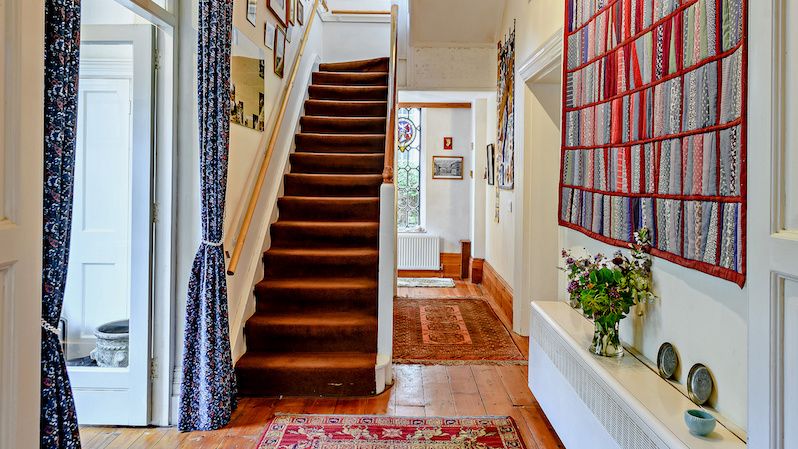
Strutt & Parker’s guide to celebrating the perfect family Burns Night at home
Mark the birthday of history’s ‘Greatest Scot’ with the help of traditions old and new.


| As the name suggests, the ‘open plan’ home was designed to create a seamless flow between living areas with minimal or no barriers between functional spaces. Born in the 1970s, open plan has been the most popular configuration for home interiors since the late 20th century. However, recent studies suggest a reversal in trends, as many of us seek to compartmentalise our homes to provide greater flexibility to incorporate work, play, social space and space for solitude under the same roof. To better understand this shift in trends, Strutt & Parker look back at the history of open plan living and consider how corona virus and its effects on our daily lifestyles might impact the design of our homes going forward. The history of open plan Early houses, such as those built in the 17th century, often consisted of just one or two multipurpose rooms, incorporating everything from cooking to sleeping areas within a single space. However, with industrialisation came increased prosperity and by the close of the 19th century people were able to enjoy larger homes with multiple rooms. For the first time, interior space was divided specifically by function, with reception rooms for entertaining, a kitchen separate from the dining area and bed chambers providing a clear distinction between public and private spaces. So what was it then, that caused architects to return to the idea of multi-functional living? The revolution came at the dawn of the 20th century and was brought about by two key developments. The first of these was advancing technology. Central heating from hot-air grilles and steam radiators negated the need for fireplaces, allowing rooms to be arranged more flexibly. Meanwhile, new construction materials, such as concrete and steel, made it possible to create larger open plan spaces with fewer supporting or dividing walls. Secondly, the set-up of the average household was changing. As society evolved from Victorian formality into something more relaxed, it became more common for family members to perform their own household chores as opposed to keeping servants. It no longer made sense therefore, for homes to be divided so stringently based on function, with open plan providing the perfect solution for a more relaxed and sociable family home. The corona virus effect In our latest Housing Futures survey, 43% of prospective home buyers said they will be looking for a ‘conventional’ layout in their next home, despite open floor plans having been the dominant architectural trend in new construction since the 1990s. Further research by John Lewis offers suggestions on why this might be. According to the John Lewis Flexible Living Report, over the course of the pandemic, one in five of us have reconfigured an open plan space within our homes to accommodate multiple activities throughout the day – such as working, exercising and home-schooling. Meanwhile, more than one third of those who took up a new hobby during lockdown likewise made a space for it within their homes. It is clear then, that the way we view our homes in terms of functionality, has evolved over the last year. And many, it seems, do not expect this to reverse after the pandemic has run its course. Over half (57%) of people say they expect to continue homeworking in the future, requiring them to find a permanent working space at home. In fact, more than a quarter (28%) have already repurposed a room to create a home office. A further 21% say they have set up an area to practice a hobby, while 20% say they have reconfigured space to give members of their household the ability to spend time alone – a trend that is perhaps all the more pertinent for those living in multi-generational households. Three-quarters of homeowners say they were saving for their home during lockdown and are now planning to spend up to £5,000 to make necessary home improvements. Generational needs Another reason the trend may be shifting toward more segregated living set-ups can be seen in the rising number of households now sharing their space across multiple generations. The latest findings by CBRE Group suggests multi-generational households are up 38% since 2009, with 1.8 million UK households now spanning two or more adult generations. There are a number of reasons for this trend, and while not all of them were initiated by the pandemic, many are sure to be exacerbated by it. The number of young people living at home into their 20s and 30s, for example, is something that is likely to continue as the lasting impacts of COVID-19 on the economy and jobs market is realised. An ageing population will likewise continue to be a driving factor toward multi-generational homes. Learn more about the rise of co-living and multi-generational homes in our blog: Is co-living the cure for loneliness? Looking to the future Take inspiration for your next home search from some properties currently on the market: Wynding House in Northumberland is an 18th century, Grade II listed house with a welcoming reception hall, spacious sitting room and separate dining room with beautiful wooden floors, and a generous fully fitted kitchen/ breakfast room with a separate utility area and a useful family shower room on the ground floor. Greyfriars in Suffolk, pictured above, is a Victorian family home overlooking the sea with access to the beach. The Victorian floor plan is still in place with the substantial drawing and dining rooms home to floor-to-ceiling bay windows with south-facing aspects, and ornate carved wooden panelling and fireplaces. The current kitchen has a pantry and space for a breakfast table with a surprisingly spacious separate utility/boiler room. Moncks Hall in Norfolk is a Victorian, six bedroomed family home. The house has well proportioned accommodation, suited to family living including kitchen, pantry, scullery, boot room, snug, dining room, cloak room and sitting room all on the ground floor with reception rooms connected by a central hallway. |